

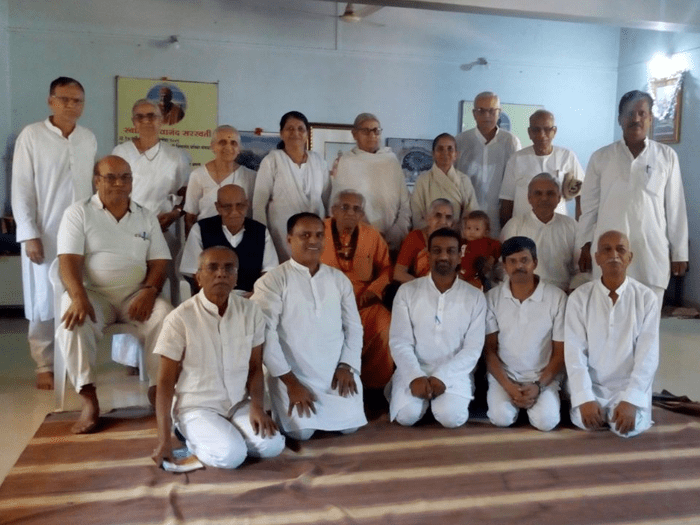
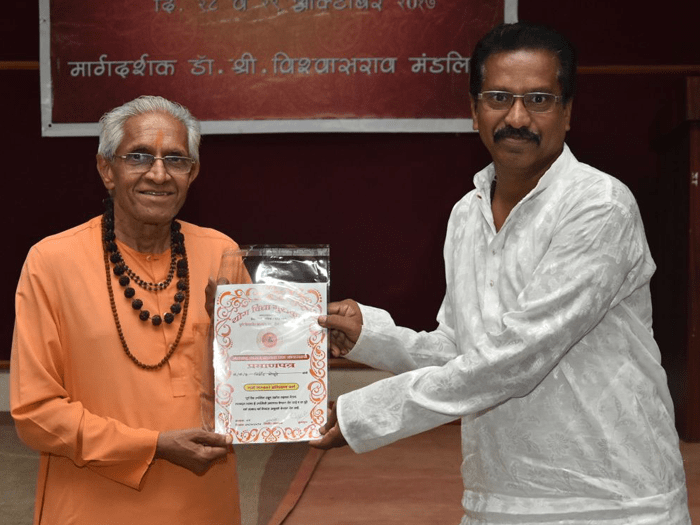
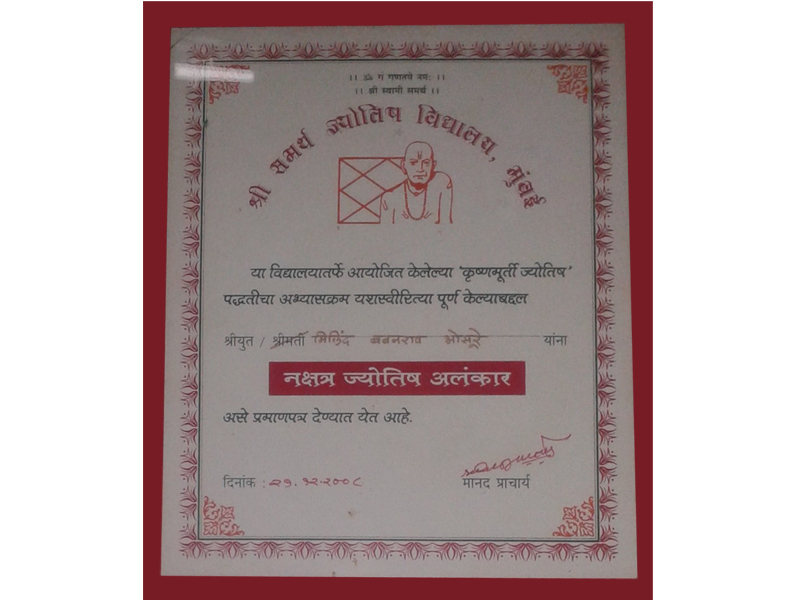


































/2.jpg)


















The present study aims at finding out the effect of Yoga Nidra on stress and anxiety on neighborhood persons. The study was conducted at the Dr.Nitin Nargunde‘s swamini clinic,vadagaon sheri pune-14. Practice time was 30minutes and the duration was six months. 20 persons were taken from neighbour for observing the effect as well as 20 was in control group. The result shows a significant change in the practice group as Yoga Nidra positively decreases the stress and anxiety level of both the male and female subjects.
---- To assess the effect of Yoga Nidra on stress level of the subjects.
---- To assess the effect of Yoga Nidra on stress anxiety level of the subjects.
Stress (roughly the opposite of relaxation) is a medical term for a wide range of strong external stimuli , both physiological and psychological , which can cause a physiological called the general adaptation syndrome , first described in 1936 by Hans Selye in journal ‘Nature’. It can be understood as tension: (psychology) a state or mental or emotional strain or suspense.
Today, life-style such a cigarette smoking , habitual hostility, suspiciousness towards others, a diet high in fact and low in fiber, and a sedentary way of life leading to many psychological problems and psychosomatic problems .Stress and anxiety have become major killers in our developed world , particularly the youth persons are loosing their confidence and getting the academic stress. A disturbing trend in youth persons health is reported the increase in young persons stress nationwide. Good mental health is one of the greatest resources for vitality, creativity and wealth, while poor health in contrast significantly drains the aforementioned. When stress is perceived negatively or becomes excessive, youth persons experience physical and psychological impairment. Hence it is necessary for the people to induce a complete relaxation technique, through which they can prevent themselves from a well-known disorder.
The author of hatha yoga pradipika , great yogi swatmarama classifies Yoga Nidra as the state of turiya ; means the all expensive and encompassing ‘fourth dimension’ in which shakti neither contracts nor expands , but is in union with shiva or supreme consciousness .
Abhyaset khecharim tavadyavant syadyoganidritah / Sampraptyoganidraya kalo nasti kadachana //
Meaning: khechari should be practiced until yogic sleep occurs. For one who has attained yogic sleep, time become non-existent. Here the term Yoga Nidra has used as the state of Samadhi. Yogic sleep or Yoga Nidra is the state in which conscious mind subsides but awareness remains.
Yoga Nidra is probably best-known technique to induce complete physical mental and emotional relaxation. Yoga Nidra is a state of consciousness, which is neither sleep nor awaken, neither is it concentration nor hypnotism. It can be defined, as an altered state of consciousness.
According to Maharashi Markandeya Yoga Nidra is the state of deep relaxation as Lord Vishnu Himself uses this marvelous technique.
Utpanneti Tada LOke Sanityapybhidhiyate / Yoganidram Yada Vishnurjagatyekarnavikrite //
- (Devi Mahatma Chapter 1, Verses 66) Maharashi Markandeya according to his visualizations states in his text Markandely Purana that at the end of Kalpa when the entire universe was in a deep relaxation Lord Vishnu was lying on bed of serpent in the state of Yoga Nidra.
Drastwa Tavsurau Chograu prasuptam Cha Janardanam / Tustav Yoganidram Tamekagrahridyasthitih //
- (Devi Mahatma Chapter 1, Verses 69) Meaning:- when Lord Brahma observed Him in the state of Yoga Nidra to make him awake. He started praying the lordess Yoga Nidra which lives in the eye of Lord Vishnu.
In Yoga Nidra, it is not necessary to concentrate. One should just keep the mind moving from point to point and be aware of every experience. Yoga Nidra means sleep with a trace of awareness.
Various studies have to been done in different part of world for observing the effect of Yoga Nidra. M.J. Cooper, (1979): in an important study at the university of Tel Aviv (Israel) says that Yoga Nidra significantly lowered levels of serum cholesterol in cardiac patients.
Erskine-Milliss, J. & Schonell, M., (1979) states that, the future role of Yoga Nidra in coronary care and management regimes appears to be a major one. The value of the practice of Yogic relaxation in prevention of cardiovascular diseases has been fairly well recognized and accepted. In the other study conducted at the Stanford university school of medical (U.S.A.) W.S. Agras (psychiat J.): demonstrates that the drop in blood pressure induced by daily Yoga Nidra practice has a far reaching effect, extending throughout the day, and is not merely a transient effect coincident with the practice session.
Another controlled study, which was conducted at the Langley porter Neuropsychiatry Institute in California, Lekh raj bali (Med. Dec. 1979): found that a reduction in blood pressure an anxiety levels in hypertensive patients continues for 12 months after Yoga Nidra training. The above study shows that researchers are keen to know the effect of Yoga Nidra in various directions; Thus it is the right time to go deep into the search of the impact offers Yoga Nidra having the above mentioned aims and objectives.
20 persons (10 males, 10 females) of ranged 20-30 years from neighbor persons were selected for practice of Yoga Nidra assigned to the experimental group. One of the groups of 20 persons (10 males, 10 females) of same age group are considered as control groups.
Both the group experimental and controlled group is from our satsung ; so all had been practicing the set of asanas, pranayamas and shatkarms regularly. For the experimental group it was an only difference that they where practicing Yoga Nidra for half an hour daily. Before starting the practice of Yoga Nidra both the group went under through few psychological tests.
Practice of Yoga Nidra in this study is the simplest method of relaxation which is being practiced in the flat lying position of shavasana and follows the spoken instruction by me. The practice includes the resolve, body part awareness, breath awareness & visualization.
To assess the impact of Yoga Nidra parameters were stress and anxiety. For the measurement of stress and anxiety level eight state questionnaire, Developed by Barton, Cattell and Curran in 1973 and adopted by S.D. Kapoor: published and reprinted in India by the psycho Centre, New Delhi, had been applied. After the six months duration the same test again being applied and the data’s at 0.01 significant levels are as shown;
The practice of Yoga Nidra will decrease the Anxiety level of male subjects of practice group.
| Mean | sd | ‘t’ value | Significant level | |
| Experimental | 4.80 | 1.15 | 2.4 | at 0.01 |
| Control | 4.78 | 1.30 |
Mean and standard deviation of the experimental and control group for anxiety level in male subjects are given in the Table 1. It is observed that there is a positive change in the level of anxiety between both the groups. The significant level for observing the t value is 0.01 and it shows the significant change in stress level as ‘t’ value is 2.4.
| Mean | sd | ‘t’ value | Significant level | |
| Experimental | 5.22 | 1.37 | 2.1 | at 0.01 |
| Control | 5.35 | 1.45 |
Mean and standard deviation of the experimental and control group for anxiety level of female are given in the Table 2. It is observed that there is a positive change in the level of anxiety between both the groups. The significant level for observing the t value is 0.01 and it shows the significant change in stress level as ‘t’ value is 2.1.
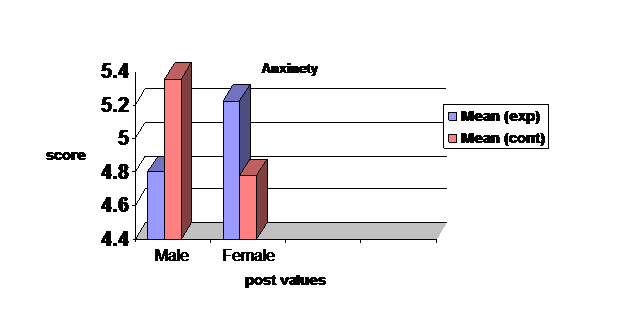
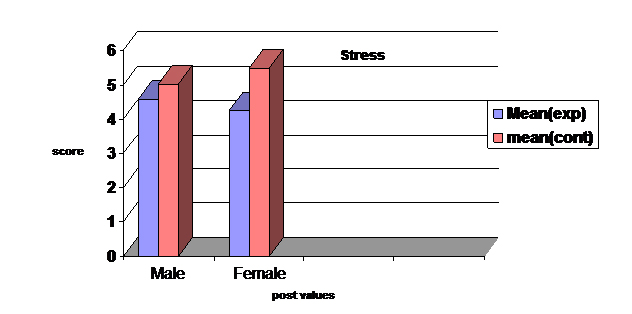
Hypothesis (3) : The practice of Yoga Nidra will decrease the stress of male subjects of practice group.
| Mean | sd | ‘t’ value | Significant level | |
| Experimental | 4.58 | 1.37 | 2.12 | at 0.01 |
| Control | 5.50 | 1.49 |
Mean and standard deviation of the experimental and control group for stress level are given in Table 3. It is observed that there is a positive change in the level of stress in male subjects between both the groups. The significant level for observing the t value is 0.01 and it shows the significant change in stress level as ‘t’ value is 2.12.
| Mean | sd | ‘t’ value | Significant level | |
| Experimental | 4.25 | 1.72 | 3.92 | at 0.01 |
| Control | 5.03 | 1.07 |
Mean and standard deviation of the experimental and control group for stress level in Table 1. It is observed that there is a positive change in the level of stress in female subjects between both the groups. The significant level for observing the t value is 0.01 and it shows the significant change in stress level as ‘t’ value is 3.92.
Stress is a cognitive or emotional response made by the individual towards any situation, which demand adjustment. When the demands of the situation exceeds the ability of the individual distress results, which may manifest in mental and physical symptoms of abnormality. The practice of Yoga Nidra helps up in building up the coping ability. The practitioner of Yoga Nidra slowly becomes aware of the inherent dormant potentialities and thus prevents himself from becoming a victim of distress. The relaxation of Yoga Nidra relaxes the physical as well as mental stresses as it relaxes the whole nervous system. Udupa (1977) suggests the stress related disorders evolve gradually through four stages. In the first stage, psychological symptoms like anxiety and irritability arises due to over activation of the sympathetic nervous system.
Yoga Nidra can be considered as a highly effective practice for reducing stress on the basis of the present study as Yoga Nidra releases the stress of the youth persons. Practice of Yoga Nidra also reduces the Anxiety of male and female subjects both. It may have positively results for the other age groups and occupations, students also.